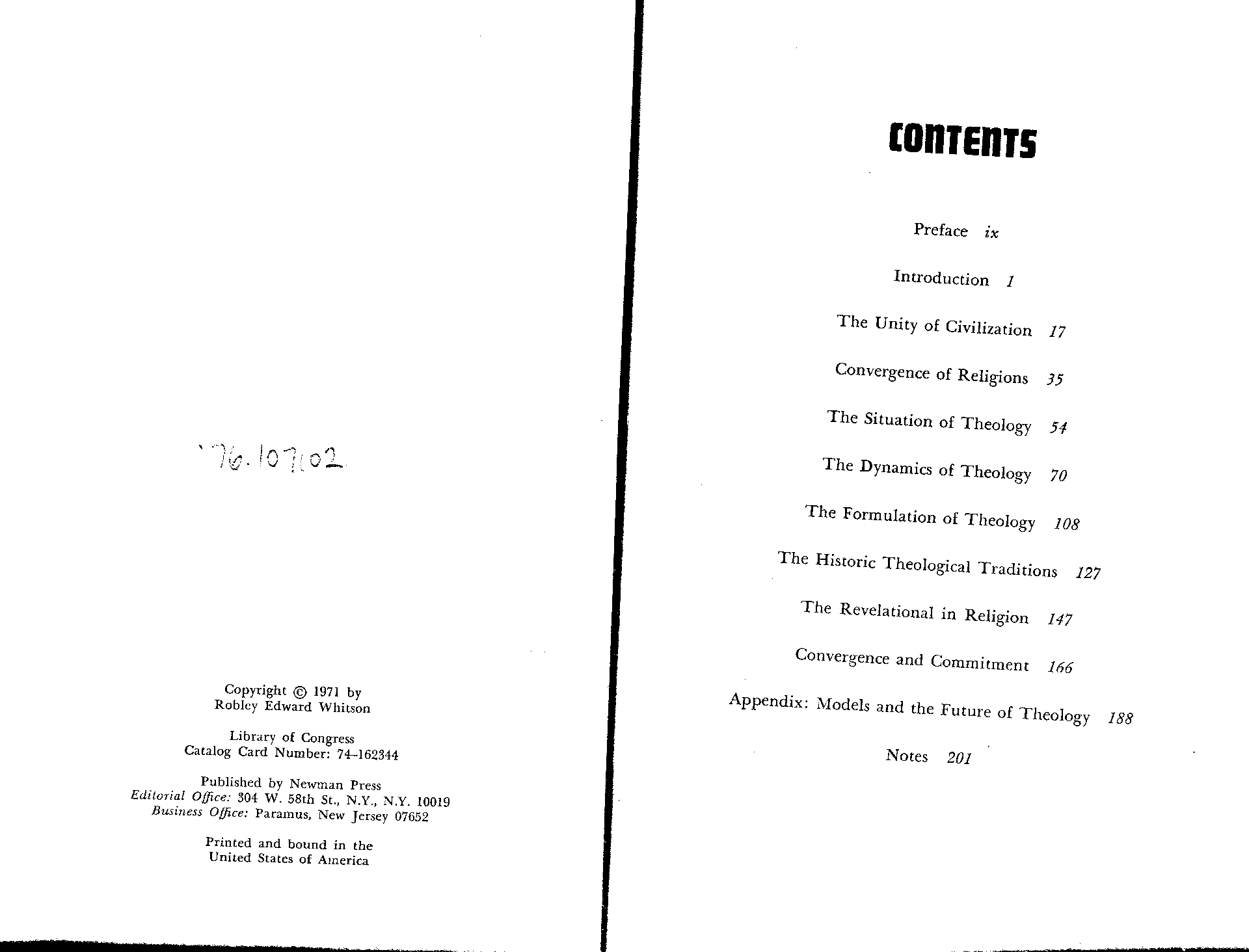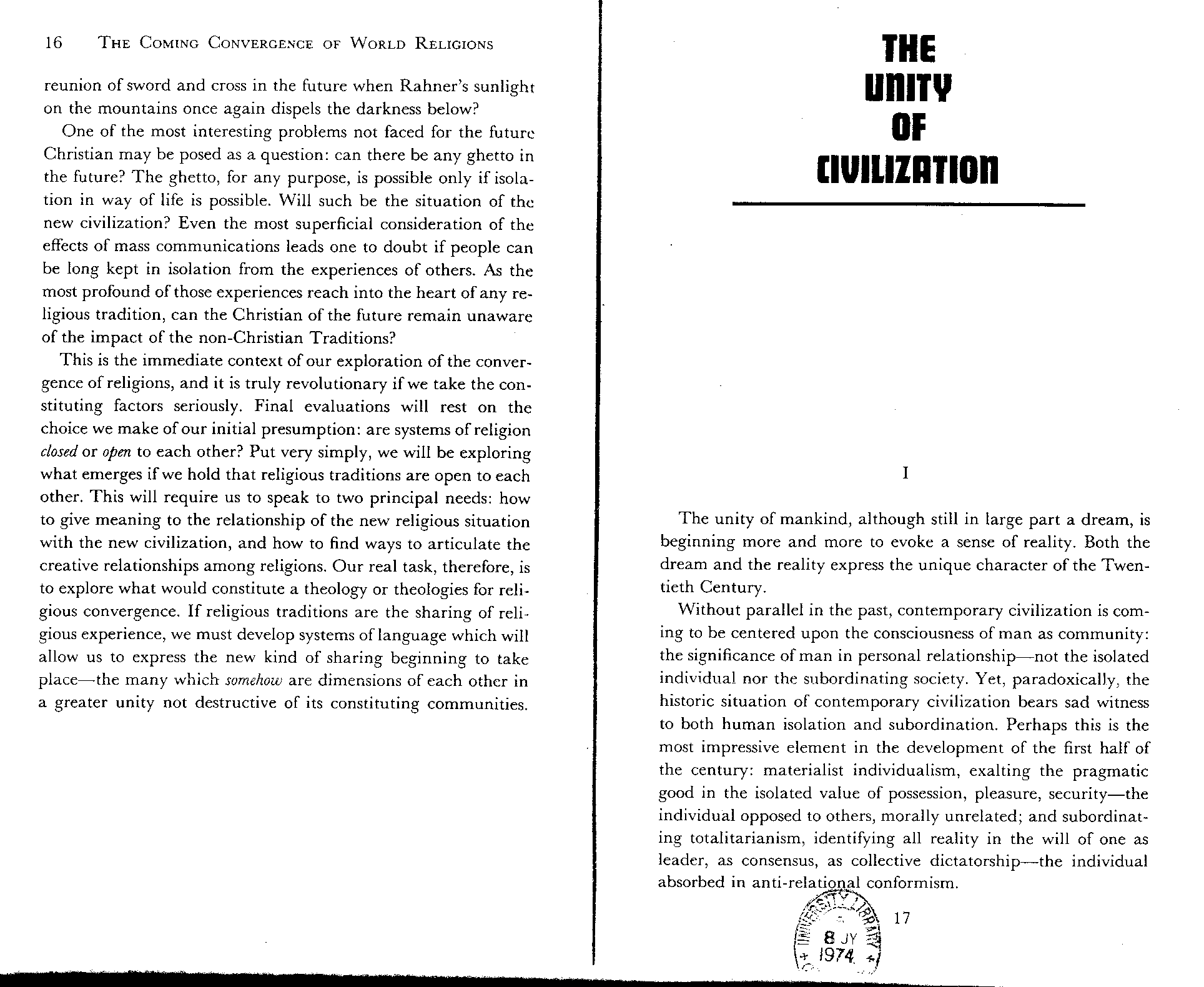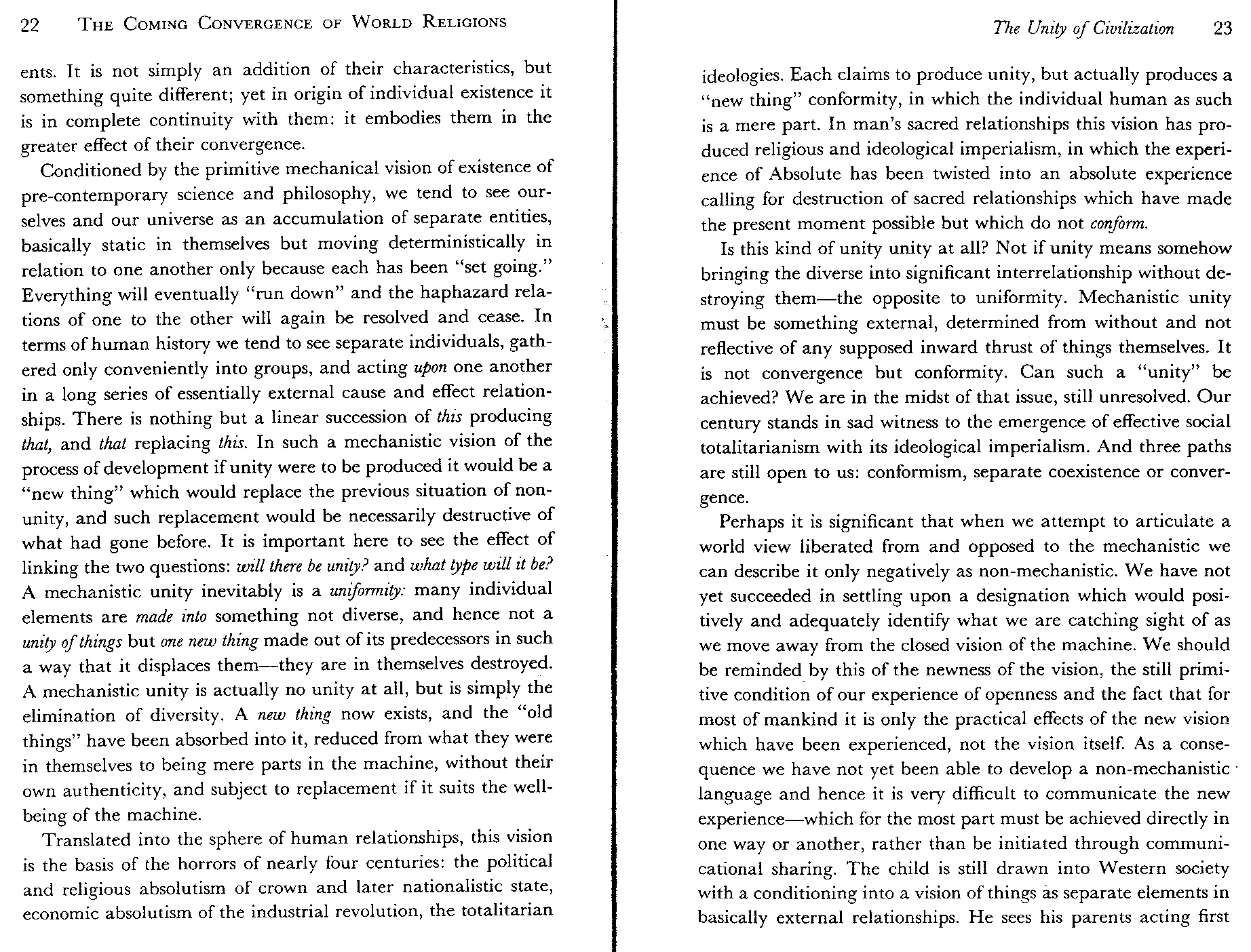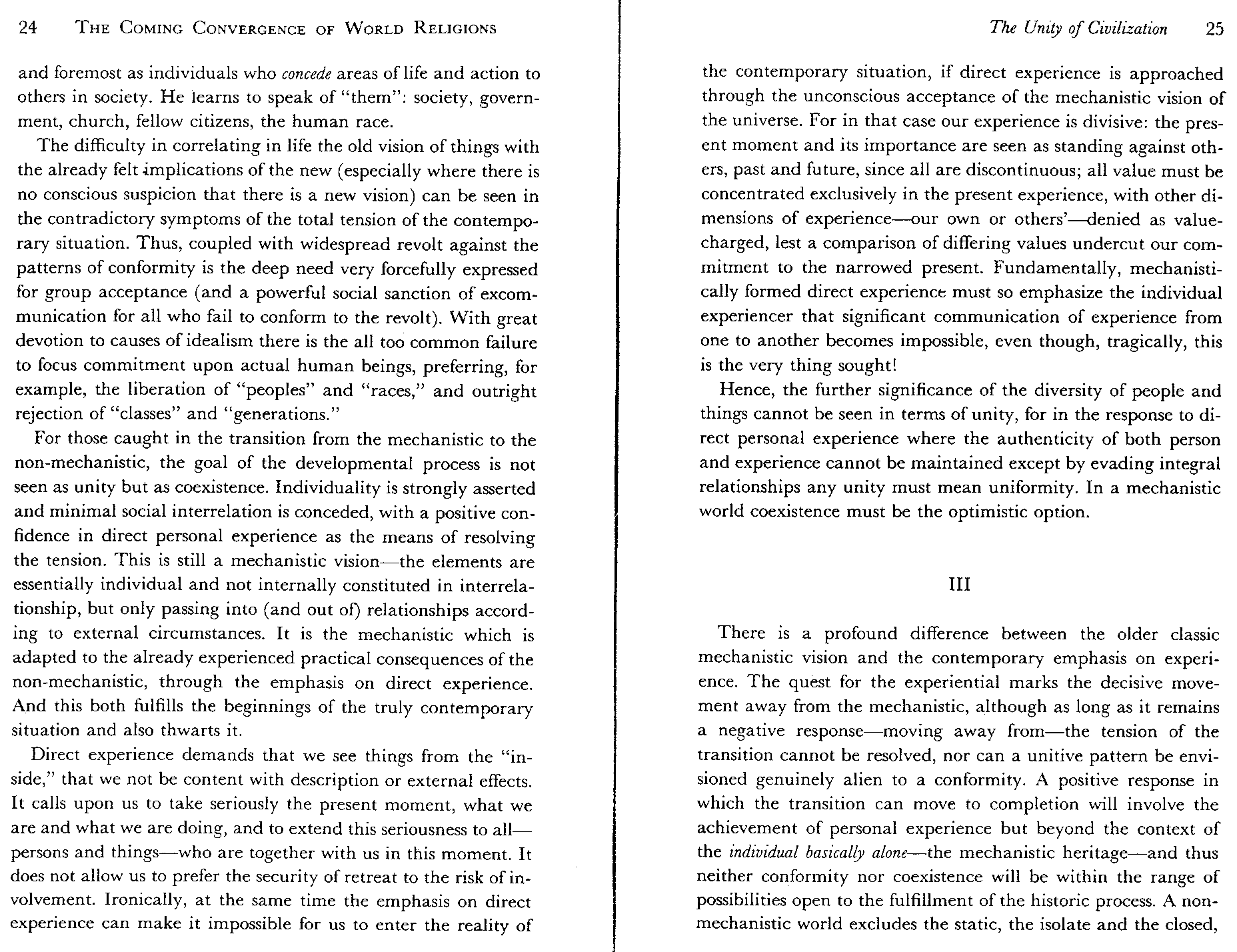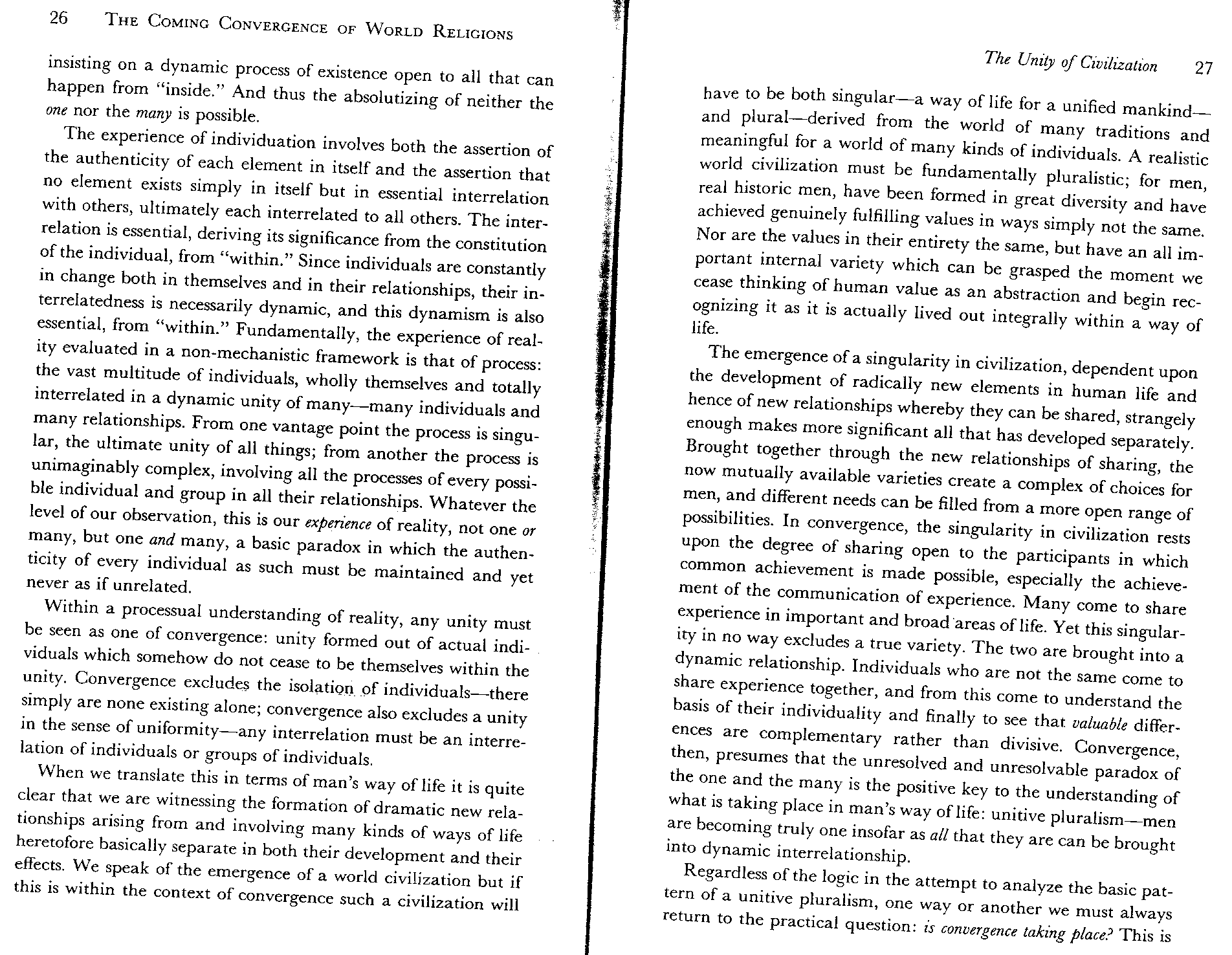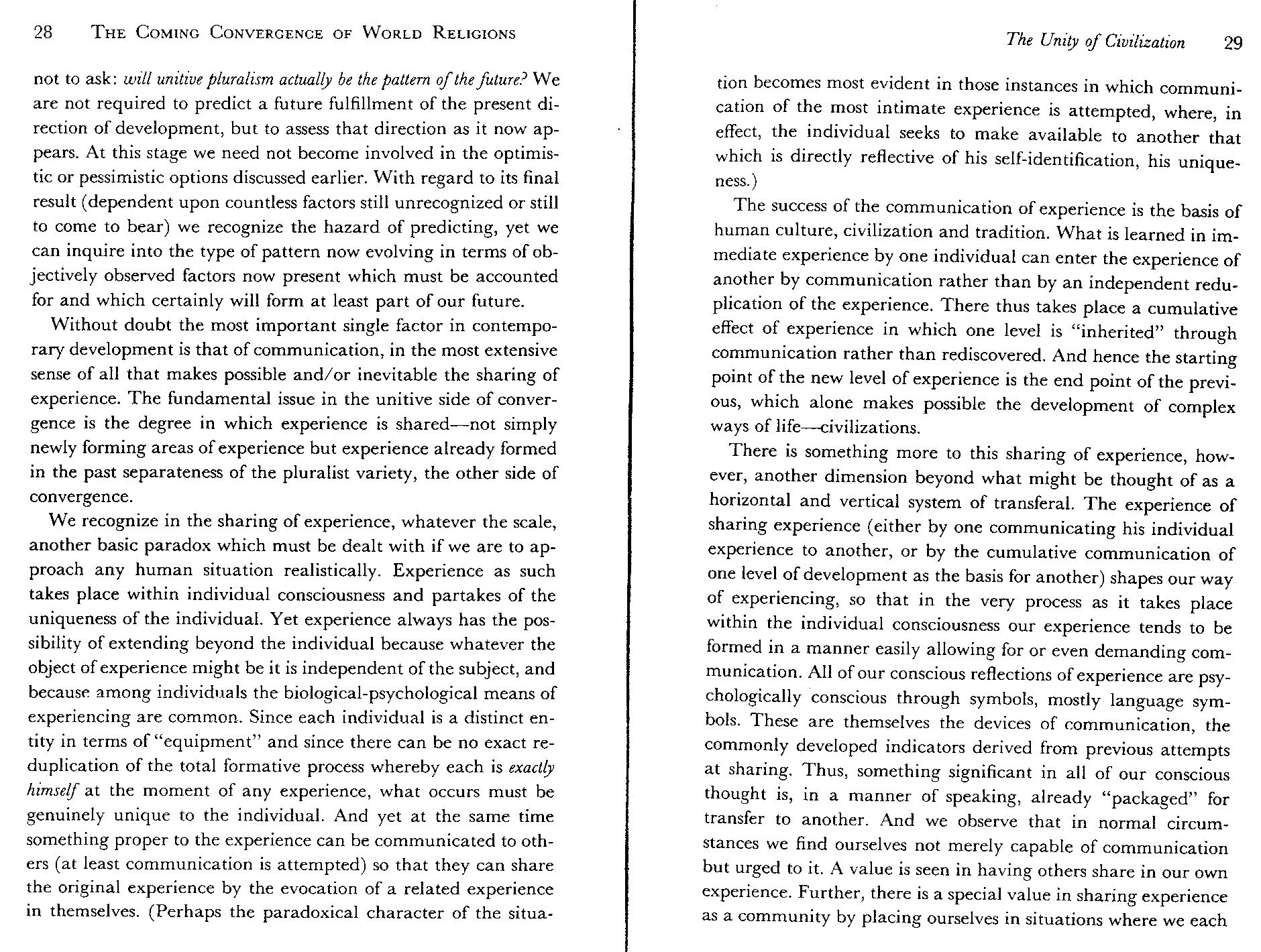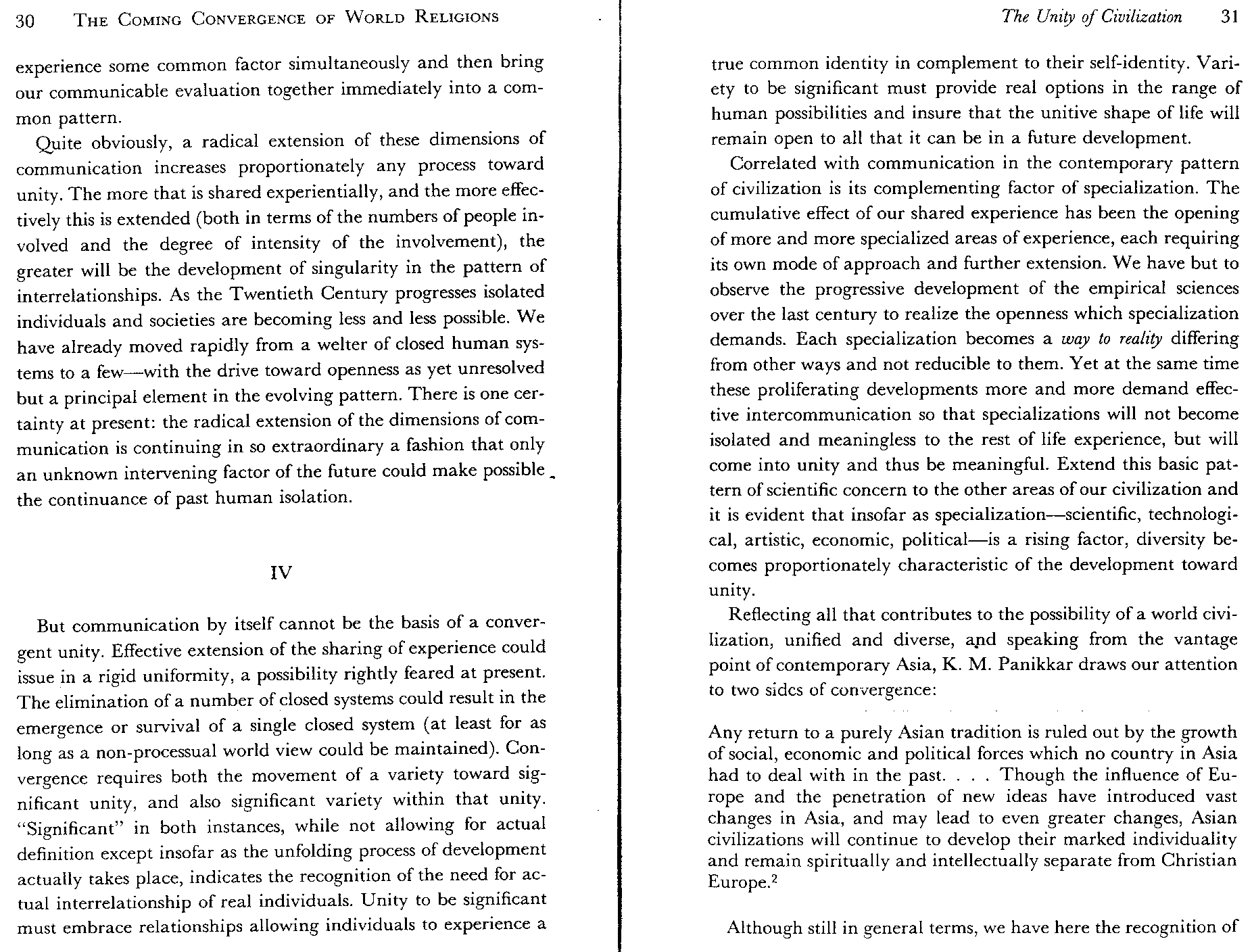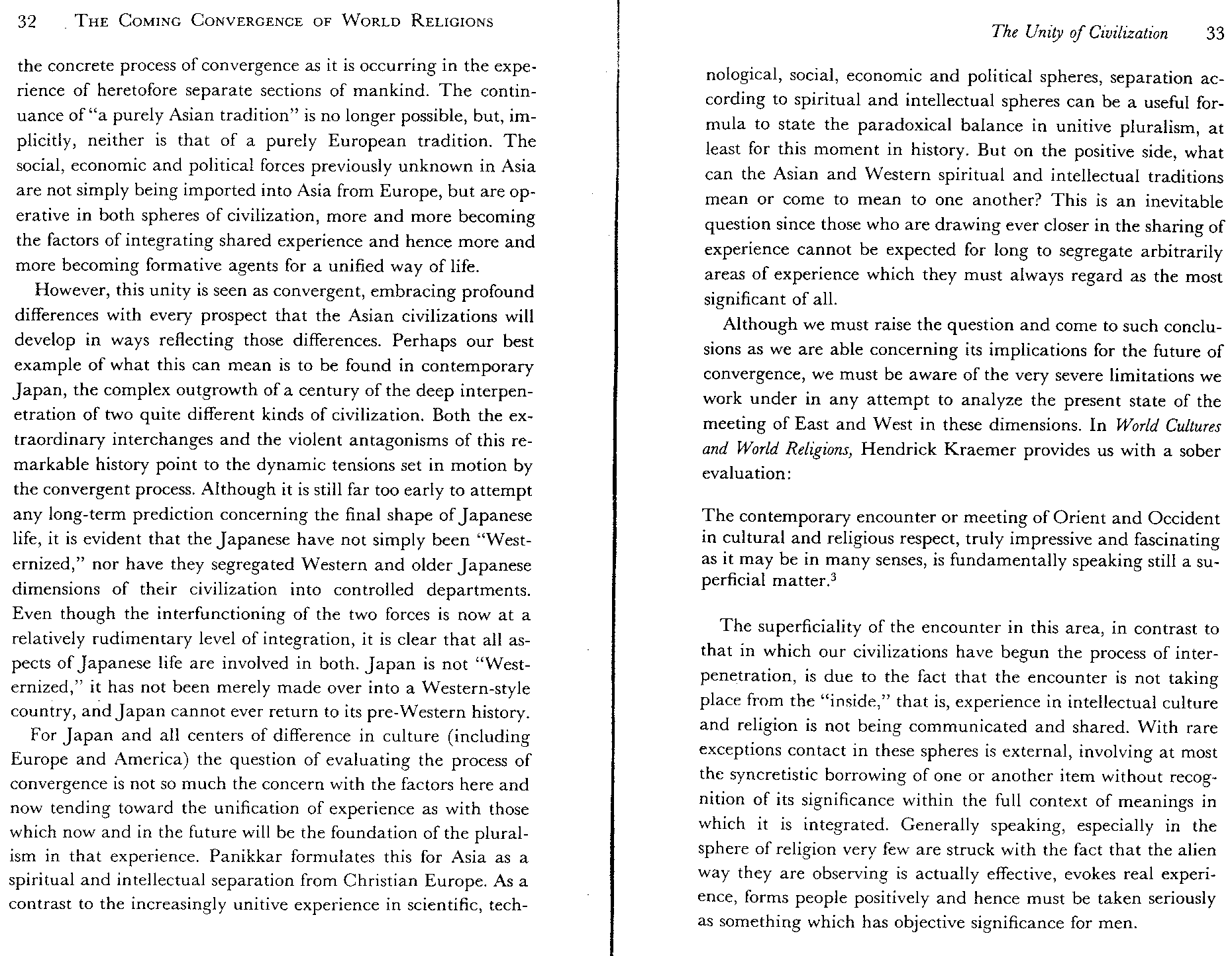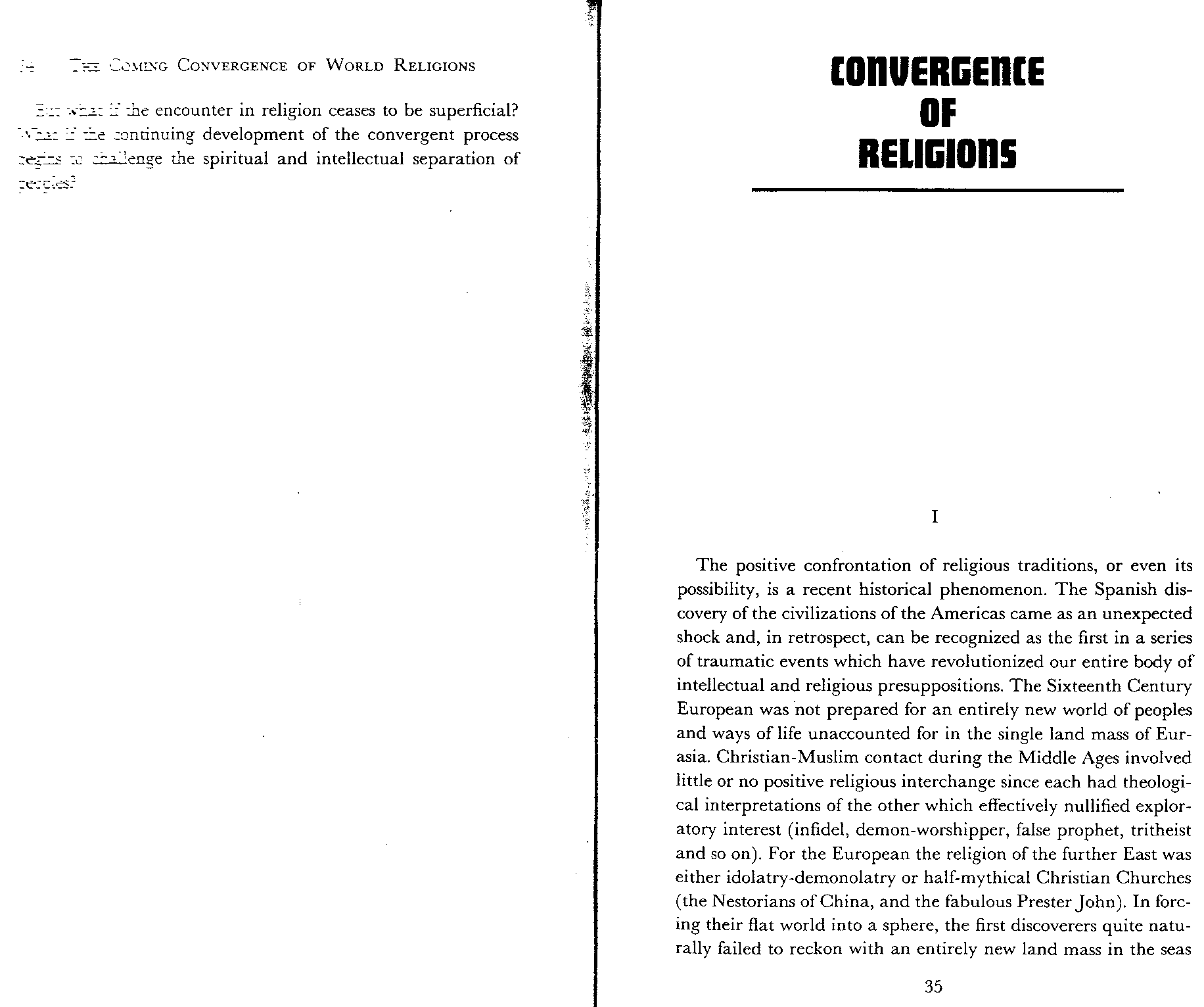
|
|
Abstract: Excerpt of a chapter on unity of humankind and civilizations. No mention of the Bahá'í Faith, but the content is of direct interest to Bahá'í studies. Notes: See this book online at Google Books or buy a copy at Amazon.com. |
The Unity of Civilization
by Robley Edward Whitson
published in The Coming Convergence of World Religions, pages 17-34New York: Newman Press, 1971
1. Text
[page 17]
I
The unity of mankind, although still in large part a dream, is beginning more and more to evoke a sense of reality. Both the dream and the reality express the unique character of the Twentieth Century.Without parallel in the past, contemporary civilization is coming to be centered upon the consciousness of man as community: the significance of man in personal relationship — not the isolated individual nor the subordinating society. Yet, paradoxically, the historic situation of contemporary civilization bears sad witness to both human isolation and subordination. Perhaps this is the most impressive element in the development of the first half of the century: materialist individualism, exalting the pragmatic good in the isolated value of possession, pleasure, security — the individual opposed to others, morally unrelated; and subordinating totalitarianism, identifying all reality in the will of one as leader, as consensus, as collective dictatorship — the individual absorbed in anti-relational conformism.
[page 18]
In the latter half of the century we find that our choice does not rest between these two. It seems, rather, that opposition to both is stimulating an awareness of a positive correspondence between man as individual and as social community. And an immediate consequent of even the most rudimentary recognition of human community is the further recognition of human unity, not simply in terms of external pressures and circumstances pragmatically forcing man to come together, but as an emerging consciousness of what man really is, and hence the consciousness that these "external" factors are not determinative causes, but dynamic reflections of the human condition.
Yet human unity has not attained more than a sense of reality for us. It is still clearly at its beginnings, still mostly dream. But perhaps now we can see it as a dream in the psychological sense — a sign from within the hidden inward side of our process of consciousness revealing our fuller life history — rather than a dream in the sense of theoretical ideal. The thrust toward unity in contemporary civilization is unique precisely because it has emerged in our consciousness from our real, experiential history, not from an abstract social theory. We can see this best in terms of problems. The sense of reality we have about human unity does not rest upon what has been achieved, but upon the appalling problems experienced (and only partly resolved) in the first half of the century and upon the problems now arising as we seek unity.
While stressing the uniqueness of our present situation and thus implying truly new issues calling — for truly new modes of confrontation, unity as a dream reflecting the inner process of human history requires us to seek to understand that history as a continuity. The uniqueness of the present cannot be an unrelated or discontinuous uniqueness, unless we would be willing to proclaim the discovery of an absolutely new human species and history, not evolved, not a process, but some sort of spontaneous creation ex nihilo. The uniqueness of the present is to be located in the emergence into our consciousness of the drive toward a real and realizable unity, a consciousness of present experience
[page 19]
pointed into the future but grown from the past with all its nonconscious implications.
Placed in such a context, the dream of unity has a very real history and reflects truly the process of existence. Whatever we observe in our world — the greatest thing, the smallest — we discover the same problem of meaning: how is it itself, and how is it that it does not exist by itself? This question must be asked when we look into the inner constitution of things, observing the variety of elements and yet the greater identity achieved somehow together. This holds true, even more impressively, when we consider things in terms of their process of existence rather than as if they exist statically as at a moment isolated from other moments. While they are real at each instant, their significance is known only insofar as we see what they do, what happens among them, the effect they have on one another — that they are not static, but "flow."
The inner meaning of the dream of unity becomes more evident when we consider living reality. Our most secure understanding of the basis of living things rests upon the recognition of their degree of organization. In a manner of speaking, the living are more unified, quantitatively and qualitatively, than "other" things. Their constituting elements are less able to preserve their identity apart from each other, and the effect of the unity of elements is dramatically beyond the individual elements themselves. Yet the reality of the living whole depends upon the unity of the individuals, both factors, and it is not possible to theorize a supposed ultimacy or priority for one or the other. In fact, the observation of assimilation of new elements and procreation of new wholes insists that we approach our understanding in terms of coordination. When we think of human history we tend to see the great diversity in mankind: the long evolutionary sequence with its many kinds of men; the widely scattered peoples and tribes with all their differing ways of life; the separate races, languages and traditions embodied in more recent millennia in great cities and civilizations. Yet, if we look closely we see this vast diversity in
[page 20]
human expression in a process of convergence: slowly and at times in almost chaotic disorder more and more interrelation takes place — separate kinds of men become fewer, hardly any men are now scattered out of contact with each other, the races move together, common languages are sought and heretofore isolate traditions are cross-fertilizing one another, and all set in new cities and civilizations becoming so vast and hence moving so close to one another that the boundaries are becoming lost. And now we can see man's world from beyond it in space, and that world is clearly round with all parts leading to all others.1
It is one whole world, but man is not now whole, not yet significantly one. And the interpretation of the process of existence and history as convergent does not guarantee man's ultimate unity. Man can fail. We have lived with the terror of that possibility for a full generation. For the first time we actually have in our hands the tools to forge our unity or our self-destruction. To know that the dream of unity is a reflection of what we really are and are to be does not mean that the dream must come true. The reality which the dream symbolizes can be suppressed, kept from consciousness and fulfillment by our suicide.
Putting aside any attempt to estimate the chances of survival, highly subjective at best, is the direction of human development actually toward unity, and if so toward what kind of unity? The evaluation of the ultimate effect of man's present direction of development is not self-evident. The same data can be interpreted in quite opposite ways. Yet there is an interesting point of departure all would seem to agree upon with little hesitation: the data show us man is evolving, either toward a greater unity or toward a more and more irreconcilable state of division. (Hardly anyone seems to think man is not evolving in any direction!) The opposition of the two evaluations is certainly reflective of a prior optimism or pessimism — which sooner or later leads again to the question of future survival since both would agree that man's dividedness contains within it the threat of self-destruction, a threat increasing or decreasing proportionately with the actual presence or absence of the elements of division.
[page 21]
In one very real sense the interpretation of our development as unitive (or divisive) is not simply an objective judgment, it is an option. The data of human experience are not "outside" the historic process, and the process in its human dimension is directly what men do within the range of possibilities open at any one point in the full context of the historic situation. The observer is also and primarily, a participant, a doer. Thus the real meaning of the question of our possible unity is: will we do it? But as the option is not absolute, being contained within the boundaries set both by non-human factors and the cumulative effect of all previous options, the answer will not be found except in the con text in which the option can be made: the range of possibilities as these possibilities actually exist at the moment of choosing and hence as they limit, condition and motivate the choosing.
II
If we follow a positive interpretation the questions of the development toward increasing unity and of the type of unity being formed become a single question embodying our understanding of the context through which the development is taking place. We have already characterized the unitive process as convergent, and it is this notion which will be used as the norm of the present attempted analysis. In an evolving process in which a variety of heretofore separate factors come to be formed into a new whole — a qualitatively and organizationally new entity beyond the additive effect of the no longer separate component elements — the new whole is not something discontinuous from the previous moment of the process. Though it may be radically different from any of the entities of that previous moment, it is continuous with the process in that it takes origin through the interrelation that occurs at one moment among elements previously unrelated in this manner. Our most forceful specification of convergence in process is probably that of biological generation, in which the offspring is clearly a new reality not identifiable singly with the
[page 22]
parents. It is not simply an addition of their characteristics, but something quite different; yet in origin of individual existence it is in complete continuity with them: it embodies them in the greater effect of their convergence.
Conditioned by the primitive mechanical vision of existence of pre-contemporary science and philosophy, we tend to see ourselves and our universe as an accumulation of separate entities, basically static in themselves but moving deterministically in relation to one another only because each has been "set going." Everything will eventually "run down" and the haphazard relations of one to the other will again be resolved and cease. In terms of human history we tend to see separate individuals, gathered only conveniently into groups, and acting upon one another in a long series of essentially external cause and effect relationships. There is nothing but a linear succession of this producing that, and that replacing this. In such a mechanistic vision of the process of development if unity were to be produced it would be a "new thing" which would replace the previous situation of nonunity, and such replacement would be necessarily destructive of what had gone before. It is important here to see the effect of linking the two questions: will there be unity? and what type will it be? A mechanistic unity inevitably is a uniformity: many individual elements are made into something not diverse, and hence not a unity of things but one new thing made out of its predecessors in such a way that it displaces them — they are in themselves destroyed. A mechanistic unity is actually no unity at all, but is simply the elimination of diversity. A new thing now exists, and the "old things" have been absorbed into it, reduced from what they were in themselves to being mere parts in the machine, without their own authenticity, and subject to replacement if it suits the well-being of the machine.
Translated into the sphere of human relationships, this vision is the basis of the horrors of nearly four centuries: the political and religious absolutism of crown and later nationalistic state, economic absolutism of the industrial revolution, the totalitarian
[page 23]
ideologies. Each claims to produce unity, but actually produces a "new thing" conformity, in which the individual human as such is a mere part. In man's sacred relationships this vision has produced religious and ideological imperialism, in which the experience of Absolute has been twisted into an absolute experience calling for destruction of sacred relationships which have made the present moment possible but which do not conform.
Is this kind of unity unity at all? Not if unity means somehow bringing the diverse into significant interrelationship without destroying them — the opposite to uniformity. Mechanistic unity must be something external, determined from without and not reflective of any supposed inward thrust of things themselves. It is not convergence but conformity. Can such a "unity" be achieved? We are in the midst of that issue, still unresolved. Our century stands in sad witness to the emergence of effective social totalitarianism with its ideological imperialism. And three paths are still open to us: conformism, separate coexistence or convergence.
Perhaps it is significant that when we attempt to articulate a world view liberated from and opposed to the mechanistic we can describe it only negatively as non-mechanistic. We have not yet succeeded in settling upon a designation which would positively and adequately identify what we are catching sight of as we move away from the closed vision of the machine. We should be reminded by this of the newness of the vision, the still primitive condition of our experience of openness and the fact that for most of mankind it is only the practical effects of the new vision which have been experienced, not the vision itself. As a consequence we have not yet been able to develop a non-mechanistic language and hence it is very difficult to communicate the new experience — which for the most part must be achieved directly in one way or another, rather than be initiated through communicational sharing. The child is still drawn into Western society with a conditioning into a vision of things as separate elements in basically external relationships. He sees his parents acting first
[page 24]
and foremost as individuals who concede areas of life and action to others in society. He learns to speak of "them": society, government, church, fellow citizens, the human race.
The difficulty in correlating in life the old vision of things with the already felt implications of the new (especially where there is no conscious suspicion that there is a new vision) can be seen in the contradictory symptoms of the total tension of the contemporary situation. Thus, coupled with widespread revolt against the patterns of conformity is the deep need very forcefully expressed for group acceptance (and a powerful social sanction of excommunication for all who fail to conform to the revolt). With great devotion to causes of idealism there is the all too common failure to focus commitment upon actual human beings, preferring, for example, the liberation of "peoples" and "races," and outright rejection of "classes" and "generations."
For those caught in the transition from the mechanistic to the non-mechanistic, the goal of the developmental process is not seen as unity but as coexistence. Individuality is strongly asserted and minimal social interrelation is conceded, with a positive confidence in direct personal experience as the means of resolving the tension. This is still a mechanistic vision — the elements are essentially individual and not internally constituted in interrelationship, but only passing into (and out of) relationships according to external circumstances. It is the mechanistic which is adapted to the already experienced practical consequences of the non-mechanistic, through the emphasis on direct experience. And this both fulfills the beginnings of the truly contemporary situation and also thwarts it.
Direct experience demands that we see things from the "inside," that we not be content with description or external effects. It calls upon us to take seriously the present moment, what we are and what we are doing, and to extend this seriousness to all persons and things — who are together with us in this moment. It does not allow us to prefer the security of retreat to the risk of involvement. Ironically, at the same time the emphasis on direct experience can make it impossible for us to enter the reality of
[page 25]
the contemporary situation, if direct experience is approached through the unconscious acceptance of the mechanistic vision of the universe. For in that case our experience is divisive: the present moment and its importance are seen as standing against others, past and future, since all are discontinuous; all value must be concentrated exclusively in the present experience, with other dimensions of experience — our own or others' — denied as value-charged, lest a comparison of differing values undercut our commitment to the narrowed present. Fundamentally, mechanistically formed direct experience must so emphasize the individual experiencer that significant communication of experience from one to another becomes impossible, even though, tragically, this is the very thing sought!
Hence, the further significance of the diversity of people and things cannot be seen in terms of unity, for in the response to direct personal experience where the authenticity of both person and experience cannot be maintained except by evading integral relationships any unity must mean uniformity. In a mechanistic world coexistence must be the optimistic option.
III
There is a profound difference between the older classic mechanistic vision and the contemporary emphasis on experience. The quest for the experiential marks the decisive movement away from the mechanistic, although as long as it remains a negative response — moving away from — the tension of the transition cannot be resolved, nor can a unitive pattern be envisioned genuinely alien to a conformity. A positive response in which the transition can move to completion will involve the achievement of personal experience but beyond the context of the individual basically alone — the mechanistic heritage — and thus neither conformity nor coexistence will be within the range of possibilities open to the fulfillment of the historic process. A non-mechanistic world excludes the static, the isolate and the closed,
[page 26]
insisting on a dynamic process of existence open to all that can happen from "inside." And thus the absolutizing of neither the one nor the many is possible.
The experience of individuation involves both the assertion of the authenticity of each element in itself and the assertion that no element exists simply in itself but in essential interrelation with others, ultimately each interrelated to all others. The interrelation is essential, deriving its significance from the constitution of the individual, from "within." Since individuals are constantly in change both in themselves and in their relationships, their interrelatedness is necessarily dynamic, and this dynamism is also essential, from "within." Fundamentally, the experience of reality evaluated in a non-mechanistic framework is that of process: the vast multitude of individuals, wholly themselves and totally interrelated in a dynamic unity of many — many individuals and many relationships. From one vantage point the process is singular, the ultimate unity of all things; from another the process is unimaginably complex, involving all the processes of every possible individual and group in all their relationships. Whatever the level of our observation, this is our experience of reality, not one or many, but one and many, a basic paradox in which the authenticity of every individual as such must be maintained and yet never as if unrelated.
Within a processual understanding of reality, any unity must be seen as one of convergence: unity formed out of actual individuals which somehow do not cease to be themselves within the unity. Convergence excludes the isolation of individuals — there simply are none existing alone; convergence also excludes a unity in the sense of uniformity — any interrelation must be an interrelation of individuals or groups of individuals.
When we translate this in terms of man's way of life it is quite clear that we are witnessing the formation of dramatic new relationships arising from and involving many kinds of ways of life heretofore basically separate in both their development and their effects. We speak of the emergence of a world civilization but if this is within the context of convergence such a civilization will
[page 27]
have to be both singular — a way of life for a unified mankind — and plural — derived from the world of many traditions and meaningful for a world of many kinds of individuals. A realistic world civilization must be fundamentally pluralistic; for men, real historic men, have been formed in great diversity and have achieved genuinely fulfilling values in ways simply not the same. Nor are the values in their entirety the same, but have an all important internal variety which can be grasped the moment we cease thinking of human value as an abstraction and begin recognizing it as it is actually lived out integrally within a way of life.
The emergence of a singularity in civilization, dependent upon the development of radically new elements in human life and hence of new relationships whereby they can be shared, strangely enough makes more significant all that has developed separately. Brought together through the new relationships of sharing, the now mutually available varieties create a complex of choices for men, and different needs can be filled from a more open range of possibilities. In convergence, the singularity in civilization rests upon the degree of sharing open to the participants in which common achievement is made possible, especially the achievement of the communication of experience. Many come to share experience in important and broad areas of life. Yet this singularity in no way excludes a true variety. The two are brought into a dynamic relationship. Individuals who are not the same come to share experience together, and from this come to understand the basis of their individuality and finally to see that valuable differences are complementary rather than divisive. Convergence, then, presumes that the unresolved and unresolvable paradox of the one and the many is the positive key to the understanding of what is taking place in man's way of life: unitive pluralism — men are becoming truly one insofar as all that they are can be brought into dynamic interrelationship.
Regardless of the logic in the attempt to analyze the basic pattern of a unitive pluralism, one way or another we must always return to the practical question: is convergence taking place? This is
[page 28]
not to ask: will unitive pluralism actually be the pattern of the future? We are not required to predict a future fulfillment of the present direction of development, but to assess that direction as it now appears. At this stage we need not become involved in the optimistic or pessimistic options discussed earlier. With regard to its final result (dependent upon countless factors still unrecognized or still to come to bear) we recognize the hazard of predicting, yet we can inquire into the type of pattern now evolving in terms of objectively observed factors now present which must be accounted for and which certainly will form at least part of our future.
Without doubt the most important single factor in contemporary development is that of communication, in the most extensive sense of all that makes possible and/or inevitable the sharing of experience. The fundamental issue in the unitive side of convergence is the degree in which experience is shared — not simply newly forming areas of experience but experience already formed in the past separateness of the pluralist variety, the other side of convergence.
We recognize in the sharing of experience, whatever the scale, another basic paradox which must be dealt with if we are to approach any human situation realistically. Experience as such takes place within individual consciousness and partakes of the uniqueness of the individual. Yet experience always has the possibility of extending beyond the individual because whatever the object of experience might be it is independent of the subject, and because among individuals the biological-psychological means of experiencing are common. Since each individual is a distinct entity in terms of "equipment" and since there can be no exact reduplication of the total formative process whereby each is exactly himself at the moment of any experience, what occurs must be genuinely unique to the individual. And yet at the same time something proper to the experience can be communicated to others (at least communication is attempted) so that they can share the original experience by the evocation of a related experience in themselves. (Perhaps the paradoxical character of the situation
[page 29]
becomes most evident in those instances in which communication of the most intimate experience is attempted, where, in effect, the individual seeks to make available to another that which is directly reflective of his self-identification, his uniqueness.)
The success of the communication of experience is the basis of human culture, civilization and tradition. What is learned in immediate experience by one individual can enter the experience of another by communication rather than by an independent reduplication of the experience. There thus takes place a cumulative effect of experience in which one level is "inherited" through communication rather than rediscovered. And hence the starting point of the new level of experience is the end point of the previous, which alone makes possible the development of complex ways of life — civilizations.
There is something more to this sharing of experience, however, another dimension beyond what might be thought of as a horizontal and vertical system of transferal. The experience of sharing experience (either by one communicating his individual experience to another, or by the cumulative communication of one level of development as the basis for another) shapes our way of experiencing, so that in the very process as it takes place within the individual consciousness our experience tends to be formed in a manner easily allowing for or even demanding communication. All of our conscious reflections of experience are psychologically conscious through symbols, mostly language symbols. These are themselves the devices of communication, the commonly developed indicators derived from previous attempts at sharing. Thus, something significant in all of our conscious thought is, in a manner of speaking, already "packaged" for transfer to another. And we observe that in normal circumstances we find ourselves not merely capable of communication but urged to it. A value is seen in having others share in our own experience. Further, there is a special value in sharing experience as a community by placing ourselves in situations where we each
[page 30]
experience some common factor simultaneously and then bring our communicable evaluation together immediately into a common pattern.
Quite obviously, a radical extension of these dimensions of communication increases proportionately any process toward unity. The more that is shared experientially, and the more effectively this is extended (both in terms of the numbers of people involved and the degree of intensity of the involvement), the greater will be the development of singularity in the pattern of interrelationships. As the Twentieth Century progresses isolated individuals and societies are becoming less and less possible. We have already moved rapidly from a welter of closed human systems to a few — with the drive toward openness as yet unresolved but a principal element in the evolving pattern. There is one certainty at present: the radical extension of the dimensions of communication is continuing in so extraordinary a fashion that only an unknown intervening factor of the future could make possible the continuance of past human isolation.
IV
But communication by itself cannot be the basis of a convergent unity. Effective extension of the sharing of experience could issue in a rigid uniformity, a possibility rightly feared at present. The elimination of a number of closed systems could result in the emergence or survival of a single closed system (at least for as long as a non-processual world view could be maintained). Convergence requires both the movement of a variety toward significant unity, and also significant variety within that unity. "Significant" in both instances, while not allowing for actual definition except insofar as the unfolding process of development actually takes place, indicates the recognition of the need for actual interrelationship of real individuals. Unity to be significant must embrace relationships allowing individuals to experience a
[page 31]
true common identity in complement to their self-identity. Variety to be significant must provide real options in the range of human possibilities and insure that the unitive shape of life will remain open to all that it can be in a future development.
Correlated with communication in the contemporary pattern of civilization is its complementing factor of specialization. The cumulative effect of our shared experience has been the opening of more and more specialized areas of experience, each requiring its own mode of approach and further extension. We have but to observe the progressive development of the empirical sciences over the last century to realize the openness which specialization demands. Each specialization becomes a way to reality differing from other ways and not reducible to them. Yet at the same time these proliferating developments more and more demand effective intercommunication so that specializations will not become isolated and meaningless to the rest of life experience, but will come into unity and thus be meaningful. Extend this basic pattern of scientific concern to the other areas of our civilization and it is evident that insofar as specialization — scientific, technological, artistic, economic, political — is a rising factor, diversity becomes proportionately characteristic of the development toward unity.
Reflecting all that contributes to the possibility of a world civilization, unified and diverse, and speaking from the vantage point of contemporary Asia, K. M. Panikkar draws our attention to two sides of convergence:
Any return to a purely Asian tradition is ruled out by the growth of social, economic and political forces which no country in Asia had to deal with in the past .... Though the influence of Europe and the penetration of new ideas have introduced vast changes in Asia, and may lead to even greater changes, Asian civilizations will continue to develop their marked individuality and remain spiritually and intellectually separate from Christian Europe.2Although still in general terms, we have here the recognition of
[page 32]
the concrete process of convergence as it is occurring in the experience of heretofore separate sections of mankind. The continuance of "a purely Asian tradition" is no longer possible, but, implicitly, neither is that of a purely European tradition. The social, economic and political forces previously unknown in Asia are not simply being imported into Asia from Europe, but are operative in both spheres of civilization, more and more becoming the factors of integrating shared experience and hence more and more becoming formative agents for a unified way of life.
However, this unity is seen as convergent, embracing profound differences with every prospect that the Asian civilizations will develop in ways reflecting those differences. Perhaps our best example of what this can mean is to be found in contemporary Japan, the complex outgrowth of a century of the deep interpenetration of two quite different kinds of civilization. Both the extraordinary interchanges and the violent antagonisms of this remarkable history point to the dynamic tensions set in motion by the convergent process. Although it is still far too early to attempt any long-term prediction concerning the final shape of Japanese life, it is evident that the Japanese have not simply been "Westernized," nor have they segregated Western and older Japanese dimensions of their civilization into controlled departments. Even though the interfunctioning of the two forces is now at a relatively rudimentary level of integration, it is clear that all aspects of Japanese life are involved in both. Japan is not "Westernized," it has not been merely made over into a Western-style country, and Japan cannot ever return to its pre-Western history.
For Japan and all centers of difference in culture (including Europe and America) the question of evaluating the process of convergence is not so much the concern with the factors here and now tending toward the unification of experience as with those which now and in the future will be the foundation of the pluralism in that experience. Panikkar formulates this for Asia as a spiritual and intellectual separation from Christian Europe. As a contrast to the increasingly unitive experience in scientific,
[page 33]
technological, social, economic and political spheres, separation according to spiritual and intellectual spheres can be a useful formula to state the paradoxical balance in unitive pluralism, at least for this moment in history. But on the positive side, what can the Asian and Western spiritual and intellectual traditions mean or come to mean to one another? This is an inevitable question since those who are drawing ever closer in the sharing of experience cannot be expected for long to segregate arbitrarily areas of experience which they must always regard as the most significant of all.
Although we must raise the question and come to such conclusions as we are able concerning its implications for the future of convergence, we must be aware of the very severe limitations we work under in any attempt to analyze the present state of the meeting of East and West in these dimensions. In World Cultures and World Religions, Hendrick Kraemer provides us with a sober evaluation:
The contemporary encounter or meeting of Orient and Occident in cultural and religious respect, truly impressive and fascinating as it may be in many senses, is fundamentally speaking still a superficial matter.3The superficiality of the encounter in this area, in contrast to that in which our civilizations have begun the process of interpenetration, is due to the fact that the encounter is not taking place from the "inside," that is, experience in intellectual culture and religion is not being communicated and shared. With rare exceptions contact in these spheres is external, involving at most the syncretistic borrowing of one or another item without recognition of its significance within the full context of meanings in which it is integrated. Generally speaking, especially in the sphere of religion very few are struck with the fact that the alien way they are observing is actually effective, evokes real experience, forms people positively and hence must be taken seriously as something which has objective significance for men.
[page 34]
But what if the encounter in religion ceases to be superficial? What if the continuing development of the convergent process begins to challenge the spiritual and intellectual separation of peoples?
2. Image scans (click image for full-size version)

|
|
